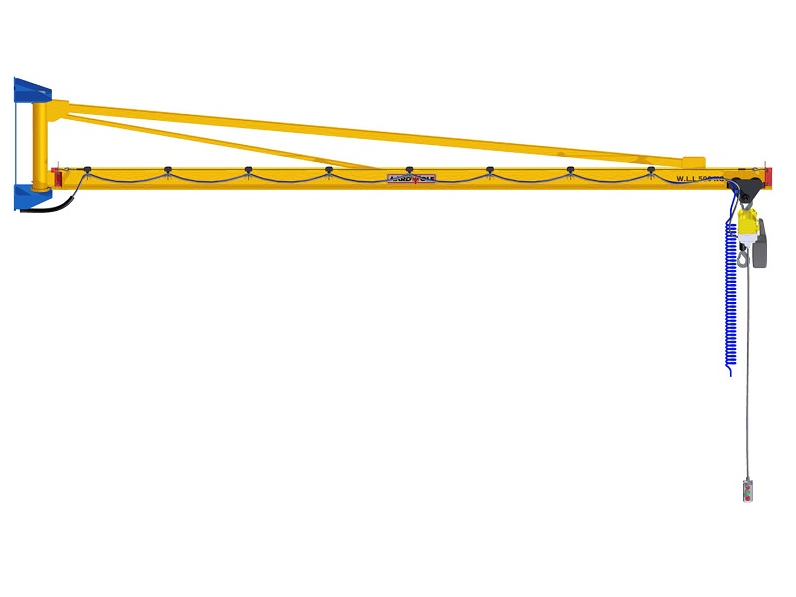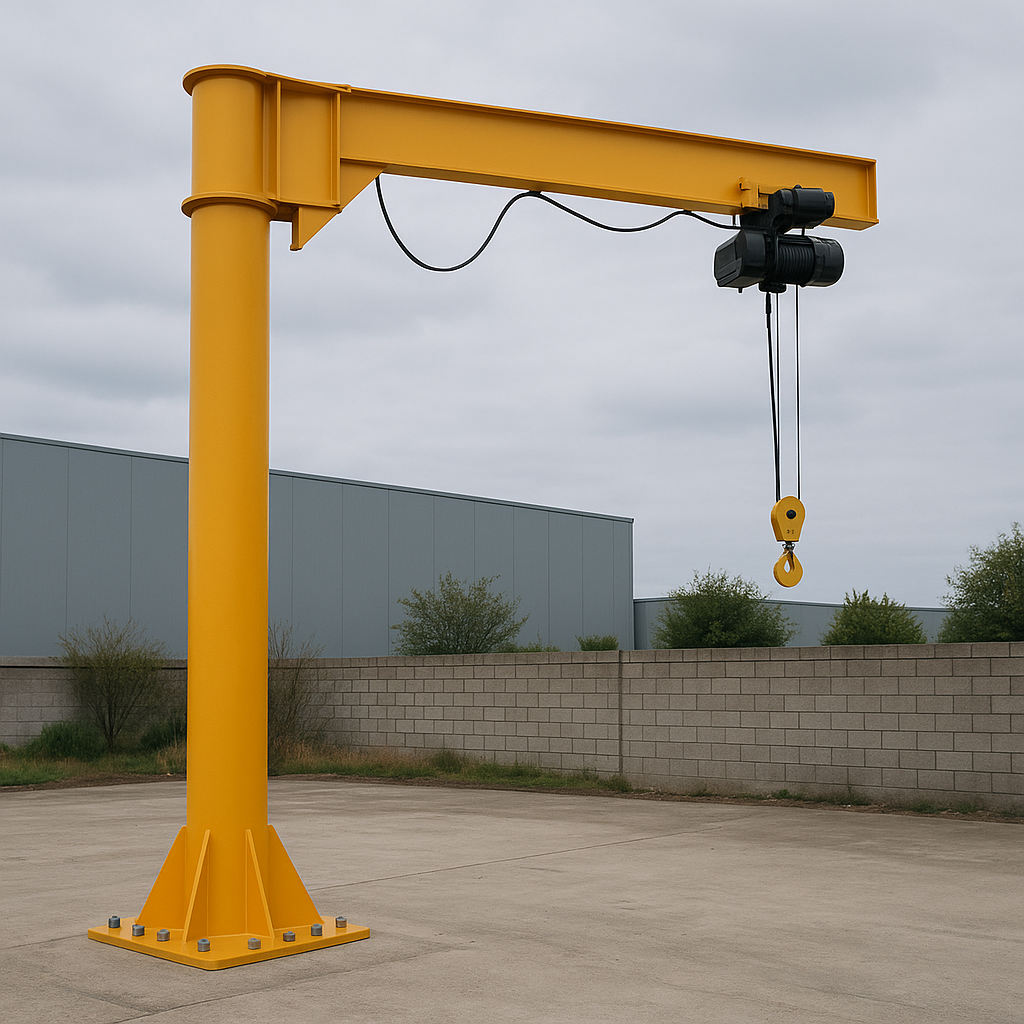Introduction to Jib Cranes
Table of Contents
ToggleA jib crane is an essential piece of lifting equipment widely used across numerous industries to handle and position loads with precision and efficiency. Distinguished by its horizontal arm (the jib), mounted on a vertical mast or attached directly to walls or pillars, jib cranes provide unmatched flexibility and operational convenience. Their design allows for controlled rotation and movement, making them a preferred solution in warehouses, manufacturing plants, construction sites, and even shipyards.
In this comprehensive guide, we’ll leverage our extensive experience and expertise in the material handling industry to explore the types of jib crane, examine their practical applications, detail their numerous benefits, and provide authoritative guidelines on their installation, maintenance, and repair.
What Is a Jib Crane?
A jib crane consists of two main parts: a vertical column or support structure and a horizontal boom or jib, which carries the lifting mechanism. The jib supports the load while enabling rotation, typically in a full or partial circle around the mast or mounting point. This design grants operators precise control over material movement within a confined space, significantly enhancing productivity and workplace safety.
Key Components of a Jib Crane
- Mast: Vertical structure providing stability and support.
- Jib (Boom): Horizontal beam allowing load manipulation and rotation.
- Hoist and Trolley: Mechanism to lift, lower, and move materials horizontally.
- Rotation Mechanism: Bearings or bushings enabling smooth rotational movement.
Types of Jib Crane
Choosing the appropriate type of jib crane depends on operational requirements, available space, and load capacities. Here are the most common types of jib cranes:
1. Freestanding Jib Cranes
Freestanding jib cranes stand independently, anchored to the floor. They offer complete 360-degree rotation and are ideal for open spaces requiring extensive reach. Due to their robust construction, these cranes can handle significant load capacities and are highly versatile in industrial settings.
2. Wall-Mounted Jib Cranes
Wall-mounted jib cranes are attached to a building’s structural walls or pillars, saving valuable floor space. They typically allow rotation up to 180 degrees. This type is best suited for limited areas where floor space is at a premium.

3. Mast-Type Jib Cranes
Mast-type jib cranes use an existing column or mast structure to support the jib, eliminating the need for additional floor supports. They provide economic and efficient lifting solutions, commonly employed in industrial plants with limited installation areas.
4. Articulated Jib Cranes
Articulated jib cranes feature two pivoting arms, offering enhanced flexibility for maneuvering around obstacles. These cranes are perfect for handling loads in tight or complicated areas requiring precise and careful placement.
For detailed insights and selection options, explore our extensive inventory for more jib crane products.
Benefits of Jib Crane Usage
Leveraging jib cranes brings multiple advantages to workplaces, significantly improving operational safety, productivity, and cost-effectiveness:
- Enhanced Productivity: Jib cranes minimize downtime through rapid and precise material handling. Workers can quickly move materials without extensive repositioning or adjustments.
- Increased Safety: By significantly reducing manual lifting and transportation, jib cranes lower the risk of workplace accidents, ensuring compliance with occupational safety standards.
- Space Optimization: Wall-mounted and mast-type jib cranes require minimal floor space, helping companies effectively utilize workspace for other operations.
- Cost-Effective Solution: Compared to larger cranes, jib cranes offer affordable solutions without compromising on quality or functionality. Reduced installation costs further boost their economic appeal.
- Versatility: Jib cranes adapt easily to diverse tasks and environments, from heavy manufacturing to light assembly and maintenance workstations.
Jib Crane Installation Best Practices
Proper jib crane installation is crucial for safe and efficient operation. Industry experts recommend the following key steps:
Pre-Installation Assessment:
- Evaluate structural integrity of walls, floors, and support columns.
- Ensure compliance with local regulatory standards and manufacturer guidelines.
Installation Procedure:
- Prepare the foundation or anchor points thoroughly.
- Secure mast or wall brackets robustly using appropriate hardware.
- Install jib components carefully, verifying alignment and rotation capabilities.
- Conduct load tests post-installation to ensure structural reliability and safety compliance.
Engaging professionals during installation ensures adherence to stringent safety standards and provides warranty protection.
Essential Jib Crane Maintenance and Cleaning
Routine jib crane maintenance is vital to ensure optimal performance, safety, and extended equipment lifespan. Incorporate regular checks into your maintenance schedule:
- Routine Inspection: Examine structural components for signs of wear or fatigue, including bolts, welds, bearings, and joints.
- Lubrication: Regularly lubricate moving parts, such as pivots, bearings, and trolleys, to minimize wear and promote smooth operation.
- Cleaning: Ensure jib cranes are cleaned routinely to remove debris, dirt, or contaminants that could affect performance or contribute to corrosion.
- Safety Checks: Regularly test hoists, brakes, and limit switches for proper functionality and adherence to safety standards.
Regular maintenance not only improves equipment reliability but also helps businesses avoid expensive downtime or repair costs.
Common Uses of Jib Cranes
The versatility of jib cranes allows them to meet diverse industrial needs effectively. Key jib crane uses include:
- Manufacturing plants: precise handling of raw materials, components, and finished products.
- Warehousing: rapid and safe loading and unloading of goods.
- Automotive repair shops: effortless handling of heavy vehicle components and assemblies.
- Construction: efficient movement and positioning of building materials at job sites.
- Maritime industry: dockside handling, cargo movement, and vessel maintenance activities.
Factors Influencing Jib Crane Prices
Multiple factors influence jib crane prices, including:
- Load Capacity: Heavier capacities necessitate sturdier designs and thus higher costs.
- Type and Design Complexity: Custom-built or articulated jib cranes typically incur higher costs compared to standard freestanding or wall-mounted models.
- Materials and Durability: High-grade steel, specialized coatings, and weatherproofing can add to the overall cost.
- Installation Requirements: Extensive site preparations or modifications raise installation expenses significantly.
Considering these elements helps buyers make informed and economically prudent decisions.
Jib Crane Repair and Troubleshooting Guidelines
Effective jib crane repair requires prompt attention to common issues, such as reduced lifting efficiency, compromised rotation, or mechanical failures. Steps for troubleshooting and repair include:
- Identifying malfunction symptoms promptly.
- Checking cables, chains, hooks, and hoist mechanisms for visible damage or wear.
- Replacing damaged or worn components with manufacturer-approved parts.
- Consulting experienced technicians for complex mechanical or electrical issues to maintain equipment integrity.
Timely repairs enhance reliability and prevent minor issues from escalating into major operational disruptions.
Selecting the Right Jib Crane Design
Choosing the appropriate jib crane design is essential for achieving operational excellence. Consider the following criteria during selection:
- Operational scope (load capacity, rotation radius, frequency of use).
- Spatial constraints and facility layout.
- Environment (indoors, outdoors, harsh conditions).
- Integration needs with existing workflow or equipment.
This thoughtful selection ensures maximum productivity, safety, and operational longevity.
Conclusion
Incorporating jib cranes into material handling operations enhances productivity, safety, and cost efficiency, delivering significant value across multiple sectors. Selecting the right type of jib crane, adhering to best practices in installation, maintenance, and repairs, and carefully managing costs ensures optimal performance and reliability.
Leveraging our industry-leading expertise, we provide trustworthy guidance and robust jib crane solutions to empower your business.
Explore our complete product range for more jib crane products and elevate your material handling capabilities today.

















Please log in to leave a comment.